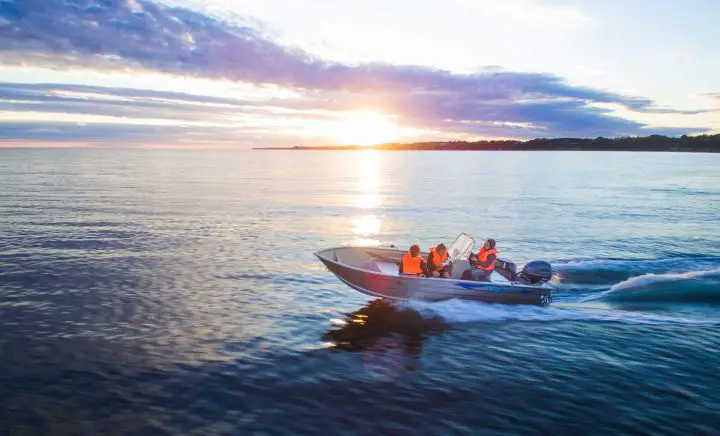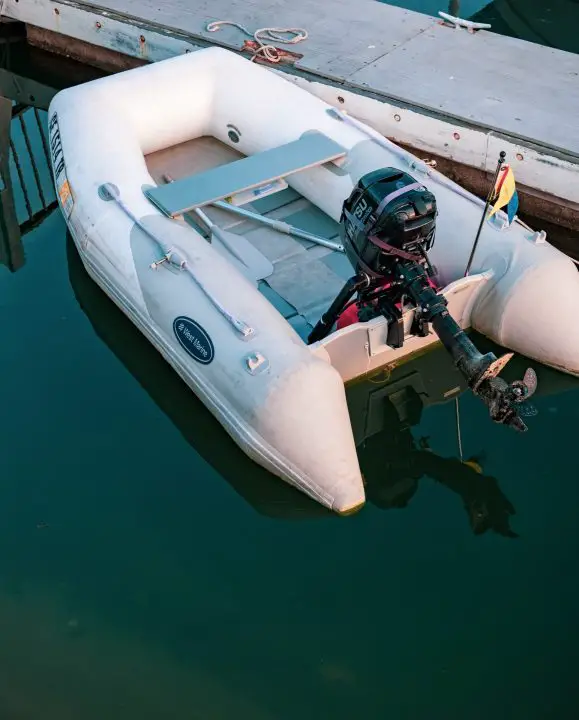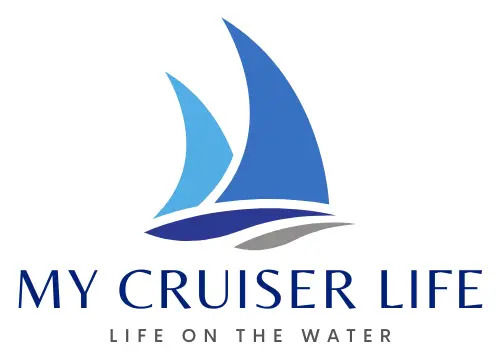Whether you’re at the helm of your inflatable tender, a center console fishing boat, or a decked-out express cruiser, go-fast boats aren’t much fun unless they go fast! And if your boat won’t plane out, you can’t go fast.
There are a lot of reasons why a boat won’t plane, so let’s take a look at precisely what it means to get a boat on plane and how to fix it when you just can’t quite get it up.
Table of Contents
- What Does it Take to Get a Boat on Plane?
- Understanding Planing-Hull Boats
- Why Won’t My Boat Get on Plane – Top Reasons
- Tips to Help Your boat get on plane faster
- What to Do When Your Boat Motor Won’t Plane Out
- Boat Wont Plane Out FAQs

What Does it Take to Get a Boat on Plane?
Getting a boat to plane isn’t as easy as you might think. It takes a perfectly designed hull and an engine that is perfectly matched. There must be enough power for the boat’s weight, and the engine and propeller must be in top working order.
There are two primary times when an owner might wonder why won’t my boat get on plane. First, if the performance of your boat changes suddenly and all of a sudden your boat wont plane, it’s time to begin troubleshooting. What has changed, and what could cause the problem?
Secondly, if you’ve just bought a new boat or motor and the performance isn’t what you expected, you might be looking for ways to improve your rig’s performance. It’s the same scenario as above, except this time you don’t know for sure if the boat ever planed—is this just what it does, or is something wrong with it.
Understanding Planing-Hull Boats
Boat hulls come in three basic types – displacement, semi-displacement, and planing. Only planing boats can get on plane – they require a particular hull shape and enough horsepower to lift the boat on top of its bow wave.
Boats are also optimized for various purposes. For example, a bass boat might be rigged for the best top speed so that it can get to the best fishing hole in no time at all. On the other hand, you might rig a ski boat for the best hole shot. Hole shot is how quickly the boat gets up on plane.
Why Won’t My Boat Get on Plane – Top Reasons
If you have a planing boat, the day might come with it won’t get on plane. Here’s a list of the most common reasons that might cause a boat to not get on plane.
- Motor mechanical issues
- Damaged propeller
- Dirty or fouled hull
- Improper motor trim
- Wrong trim tab setting
- Boat is overweight or out of balance
- Inflatable tube pressure low
Motor Mechanical Issues – Fuel Pump, Filters, Etc.
With power being such a big part of getting a boat on plane, it should be no surprise that one of the first troubleshooting steps you should take is to ensure that your engine is performing as it should.
Modern outboard and I/O motors have warning lights, just like cars. So if there’s a check engine light or a maintenance required light, make sure you know why it’s on. If it is, it’s probably worth taking your boat in to the shop and discussing the problems you’re having with a good boat mechanic.
Generally, however, outboard motors are incredibly reliable so long as they are provided with clean fuel. The first troubleshooting step for nearly every engine problem is to ensure that clean fuel is supplied to the motor. Change all your fuel filters. If there’s the slightest hint of water in them, it’s a big clue as to one possible cause of your woes.
Another potential problem could be a lack of cooling water. Boat motors use seawater to cool them instead of air. A small rubber impeller is used to draw the seawater through the system. This impeller has a short lifespan and is easily damaged. Most boaters replace the impeller annually.
Check your engine’s cooling water flow after every start-up. If you notice it getting less over time, replace the impeller sooner rather than later. Modern engines have electronic governors that limit their power output when they overheat. This is yet another possible reason why your boat will not plane.
It’s never a bad idea to take your boat to the local marina mechanic and have it gone over. They’ll check for bad spark plugs, ignition coils, fuel related issues, vacuum leaks, and any other issues that might cause problems at high speeds. A compression test can show internal engine issues that might not otherwise be apparent.
Damaged Propeller or Prop Hub
Propellers might seem simple items, and in some ways, they are. But the shapes of their blades are engineered very carefully and designed by computers these days. Plus, props lead rough lives. A little bit of sand can blast the paint right off aluminum props, and a tiny rock is enough to trash even the most hearty stainless model.
Something as simple as a dinged propeller could very well be the cause of your planing problems.
The only way to know your props condition for sure is to take it to a prop shop that can inspect it properly. They should be able to confirm the pitch of each blade and let you know if it is the cause of your issue.
Another issue to look out for is a spun hub on your prop. The rubber hub of a boat propeller is mounted on a spline that mates to the prop shaft. If the prop hits an object or gets wrapped in a rope and fouled, the prop shaft can still spin. This prevents more expensive damage to the motor and gearbox.
But once a prop has spun, it will not generate full power again until the hub is replaced. As more power is added, it will slip like a bad clutch in a car. You should be able to limp back to the dock, but not on plane.
Dirty or Fouled Hull
If your boat lives in the water, a dirty hull can cause enough drag that your boat wont plane out. The amount of underwater growth varies greatly depending on the nutrients in the water and the water temperature. Some areas experience high growth for a few months a year, while others have high-growth year-round.
In a high-growth area, algae and slime will begin coating the bottom within about a week. This generally won’t affect performance too much. But if your boat’s ability to plane out was already marginal, it might be enough to do you in.
After three weeks or more, hard growth will begin building up on the bottom of a boat. This will drastically increase the drag on your boat and severely limit your ability to get on plane. Once hard growth has started, you’ll likely need to take the boat out of the water on a lift or trailer and give it a good cleaning.
To inhibit growth, boats stored in the water for long periods should be painted with anti-fouling bottom paint. It’s not perfect, but it makes cleaning the bottom a lot less arduous task.
Improper Motor Trim
Let’s say that none of the above applies – you have a perfectly operating motor, a like-new prop, and a clean boat bottom. In that case, there’s some good news. It’s likely something easy to fix.
Outboards and sterndrives can be trimmed to move the bow up or down while cruising. The control is usually a toggle switch located on the throttle lever. Getting the trim just right will ensure that you run the boat efficiently. In some cases, having the wrong trim can keep you from getting on plane, to begin with. Trim position plays a big part in the boat’s performance.
Even small portable outboard motors have trim – it just isn’t electric. Instead, there is a pin on the outboard motor bracket that you can adjust, and you can fine-tune the angle at which the motor sits on the transom. Portables tend to be even more sensitive to trim since small boats often operate right at their limits.
When the engine trim is too bow down, too much of the hull will be in the water, causing excess drag. That means more power will be required to get on plane, which might make it hard for underpowered boats to make it happen.
But on the other hand, having too much bow-up trim is a problem, too. Most trims allow for the motor to be tilted out of the water for storage, too. The propeller can ingest air and lose efficiency if the motor is tilted too far up. In addition, the extreme angle will reduce the thrust available for forward power, making it impossible to get on plane anyway.
So the key to finding the right trim setting is to experiment a little bit. If your boat has a trim gauge, you can dial in just the right setting once you find it. Otherwise, you’ll have to guestimate. Find a setting roughly in the middle between full bow up and full bow down. Try to get on plane. If it doesn’t work, work the trim bow down a bit at a time and see if the situation improves.
Once the boat has planed out, use minor adjustments of the trim to find the best setting. A properly trimmed boat makes a clean wake on the water surface and does not porpoise.
Wrong Trim Tab Setting
Many planing boats also have trim tabs. They’re mounted to the transom of the boat on either side of the motor. Each trim tab works independently to trim the boat for different sea conditions. The trim tabs can also be set to fine-tune the bow up-down pitch for the best economy and most comfortable cruise.
Generally, start your cruise with your trim tabs centered—both neutral and even with the hull. However, some boats might be able to get on plane quicker if you start with a little bow-down trim.
Once on plane, get the engine trim set the way you want it and then fine-tune the trim tabs. The beauty of the trim tabs is rolling the boat to one side or another to meet the waves in choppy conditions. This makes for a drier and more comfortable ride.
Too Much Weight or Out of Balance
Another consideration should be how you have loaded the boat. Like an airplane flying in the sky, a planing boat flying over the water needs to have the right weight and balance.
The amount of power you have available from your motor is limited, and so too is the amount of weight you can carry. Therefore, your boat cannot be loaded for bear and then expected to plane.
The placement of weight in the boat also must be factored in. If all the weight is in the back of the boat, the hull might not get enough bow-down pitch to plane out. Move some weight forward to help get on plane and see if that helps.
Inflatable Tube Pressure Low
Rigid inflatable boats (RIBs) have one other factor that can affect their ability to plane—the inflation pressure of the tubes. Make sure your RIB is inflated to its recommended pressure before trying to get on plane. Low pressure in the tubes will cause them to deform slightly and affects the hull’s shape.

Tips to Help Your boat get on plane faster
With the tips above in mind, what if you’ve got a boat that barely planes? Maybe it is a small dinghy that planes with one person, but the boat will not plane with two people. Are there any ways to make it better? Here are a few ideas.
Reduce Weight
Small boats become underpowered quickly as you add more weight. Your 20-foot open fishing boat probably does fine with you, your buddy, and a couple of rods and reels. But when you take up scuba diving and load it with four dive tanks, weights, and other gear, all of a sudden, it won’t plane.
So don’t carry around weight you don’t need. Look at every part of the boat and see what weights you can reduce. For example, if your boat has a 100-gallon fuel tank, but you never use more than 10 gallons at a time, consider operating it at half-full or less. Consider downsizing your toolbox or just taking some of your junk off. Little things can make a big difference.
Add Trim Tabs
If your boat doesn’t have trim tabs installed on the transom, consider adding a set. They cost a few hundred dollars, but they are just what the doctor ordered for some boats. If you have other problems, like wet and rough rides in chop, the choice is easy.
Add Outboard Fins
Several companies make fins that attach to your outboard’s lower unit. They are inexpensive and very effective. However, they require drilling through the anti-cavitation plate above the propeller.
The basic idea is to make the outboard’s trim function much more effective. They also add an element of lift to the back of the boat. That helps push the bow down, which in turn helps your boat get on plane with less power. Even if your boat planes out fine, fins can help it get on plane at lower speed and theoretically can help you lower your gas bills.
Prices pulled from the Amazon Product Advertising API on:
Product prices and availability are accurate as of the date/time indicated and are subject to change. Any price and availability information displayed on [relevant Amazon Site(s), as applicable] at the time of purchase will apply to the purchase of this product.
Get a Propeller with Less Pitch
Propeller pitch is a tricky thing. Getting it perfect is a balance based on the boat’s design, the motor’s size and power, the weight carried, and the goals of the boat. All of that makes it hard to get it right the first time – so many boats come poorly pitched, to begin with. A professional prop shop can help, but trial and error is the only sure-fire way to know.
The litmus test for the propeller is to make sure that your boat motor hits its rated RPM at WOT (wide-open throttle). The RPM is published on the motor stickers and its owner’s manual.
There are usually a few hundred RPMs to play with. Within those few hundred RPM, you usually have room to pitch up or down by an inch or so. Decreasing pitch will enable the motor to swing the prop faster, thereby getting more power quicker.
Upgrade to a Four-Blade Propeller
Most powerboats have either three or four-bladed props. As a general rule of thumb, three blades give you better top-end speed, and four blades give you a better hole shot. So if your boat won’t get on plane, a four-blade propeller might help.
When you go from three to four blades, you should decrease the pitch by one inch.
Get More Power
It’s not the cheapest option, and it isn’t often required. But if your motor just isn’t doing the job you need it to do, consider getting more horsepower. This is the most effective on small boats with portable motors, but the concept applies to any size boat.
Of course, don’t exceed the power ratings for your boat’s hull. Those ratings are set to US Coast Guard standards, and putting more power than rated on the boat may not be safe. It might also void your insurance!
What to Do When Your Boat Motor Won’t Plane Out
When a boat won’t plane, there are quite a few solutions to the problem. As with most problems you face in boating, methodically troubleshooting is the first step to narrowing down what is causing the problem. Make sure that your engine and prop are indeed working as they should be, and then tinker with the easy things to change, like the load or the weight distribution.
For more boat troubleshooting:
- Boat Gas Tank Vent Problems
- Starting Motor Out Of Water
- How to Tell if Your Outboard Water Pump is Bad
Boat Wont Plane Out FAQs
How do I know if my boat prop is bad?
Start with a visual inspection. If there is any sign of physical damage to the prop, like nicks or chips, take it to a prop shop to have it checked. Even the most seemingly insignificant damage can have significant effects on planing powerboats.
A reputable prop shop should be able to analyze your prop regardless to tell you if it is still pitched as desired, balanced, and in otherwise good shape.
Why is my boat not going fast?
There are many reasons why a boat might not be going as fast as you suspect. Planing-hull powerboats need a lot of power to move fast, so start troubleshooting your engine and propeller. Make sure that everything is in tip-top shape.
Also, consider adjusting your trim settings, both on the motor and on your boat’s trim tabs (if you have them). Finally, consider removing weight from the vessel to help get on plane faster.




